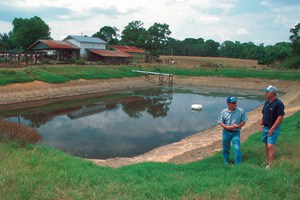By Kent McGuire – OSU CFAES Safety and Health Coordinator
 Many farmers are applying anhydrous ammonia as a part of their spring planting season. Anyone working with anhydrous ammonia should be familiar with the safe use of the product, understand the potential for injury and know how to respond to an emergency. There are several hazards associated to working with anhydrous ammonia in the field. One hazard is that anhydrous ammonia is stored under high pressure. An unintended release can occur if the equipment is not well maintained, equipment becomes damaged, or workers are not trained to follow exact procedures. Additional hazards can be based on anhydrous ammonia’s chemical properties. Contact with skin can cause freezing of tissue or chemical burns. Severe irritation to eyes can take place since anhydrous ammonia seeks out water. And because of the strong odor, inhaling anhydrous ammonia can irritate the lungs and respiratory system. Some simple suggestions when working with anhydrous ammonia in the field include:
Many farmers are applying anhydrous ammonia as a part of their spring planting season. Anyone working with anhydrous ammonia should be familiar with the safe use of the product, understand the potential for injury and know how to respond to an emergency. There are several hazards associated to working with anhydrous ammonia in the field. One hazard is that anhydrous ammonia is stored under high pressure. An unintended release can occur if the equipment is not well maintained, equipment becomes damaged, or workers are not trained to follow exact procedures. Additional hazards can be based on anhydrous ammonia’s chemical properties. Contact with skin can cause freezing of tissue or chemical burns. Severe irritation to eyes can take place since anhydrous ammonia seeks out water. And because of the strong odor, inhaling anhydrous ammonia can irritate the lungs and respiratory system. Some simple suggestions when working with anhydrous ammonia in the field include:
– Always have water readily available. This should include a squirt bottle of water with you and 5 gallons of emergency water mounted on the nurse tank.
– Personal protective equipment should include: long sleeve clothing, goggles, chemical gloves, and respirator with approved cartridge.
– Wear the proper personal protective equipment when connecting or disconnecting nurse tanks from the applicator or when making minor repairs or adjustments in the field.
– Ensure that a set of personal protective equipment is located in the cab of the tractor and in any vehicle used to transport nurse tanks. Continue reading Working Safely with Anhydrous Ammonia
 Hydrogen sulfide is a colorless, flammable, and extremely hazardous gas. It is produced by the breakdown of animal wastes or manure. It is heavier than air and can collect in both enclosed pits, open air lagoons and low-lying areas such as, ditches, or manholes. Knowing the risks that can occur with manure gas is important for those farms raising animals and for others who may visit your farm.
Hydrogen sulfide is a colorless, flammable, and extremely hazardous gas. It is produced by the breakdown of animal wastes or manure. It is heavier than air and can collect in both enclosed pits, open air lagoons and low-lying areas such as, ditches, or manholes. Knowing the risks that can occur with manure gas is important for those farms raising animals and for others who may visit your farm.

 Managing stored grain throughout the winter is an important part of your grain marketing plan for farm profitability. This winter we are already receiving reports of stored grain going out of condition, which can lower the value and be a hazard to those working around the grain facility. At a minimum, stored grain that has gone out of condition can cause health hazards, especially when grain dust contains mold and bacteria. Out of condition grain can also form a crust or stick to the bin walls and if someone enters the bin for any reason an entrapment could occur. For more information on safety when working around grain visit
Managing stored grain throughout the winter is an important part of your grain marketing plan for farm profitability. This winter we are already receiving reports of stored grain going out of condition, which can lower the value and be a hazard to those working around the grain facility. At a minimum, stored grain that has gone out of condition can cause health hazards, especially when grain dust contains mold and bacteria. Out of condition grain can also form a crust or stick to the bin walls and if someone enters the bin for any reason an entrapment could occur. For more information on safety when working around grain visit 